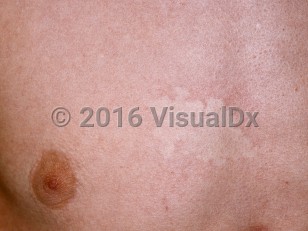Nevus anemicus in Child
Alerts and Notices
Important News & Links
Synopsis

Nevus anemicus is a cutaneous finding characterized by focal pallor of skin without textural irregularity due to congenital local hypersensitivity of cutaneous blood vessels to catecholamines. The vasoconstriction and subsequent pallor of the affected skin mimics hypopigmentation, but this usually congenital change has no associated pigmentary alteration. Nevus anemicus usually involves the trunk, but lesions on the face and extremities have been observed. It is usually first noticed at birth or in early childhood, but because it can often be subtle and is asymptomatic, it is frequently an isolated incidental finding.
Nevus anemicus may also occur in association with several syndromes, including neurofibromatosis (up to 4% of cases) and phakomatosis pigmentovascularis (PPV), a syndrome consisting of combinations of cutaneous and vascular findings that may include capillary malformations, dermal melanocytosis, and nevus spilus, caused by mutations in the GNAQ / GNA11 pathways. Nevus anemicus has also been seen in patients with Legius syndrome with confirmed SPRED1 mutation and Noonan syndrome with lentigines, with a confirmed PTPN11 mutation.
Nevus anemicus may also occur in association with several syndromes, including neurofibromatosis (up to 4% of cases) and phakomatosis pigmentovascularis (PPV), a syndrome consisting of combinations of cutaneous and vascular findings that may include capillary malformations, dermal melanocytosis, and nevus spilus, caused by mutations in the GNAQ / GNA11 pathways. Nevus anemicus has also been seen in patients with Legius syndrome with confirmed SPRED1 mutation and Noonan syndrome with lentigines, with a confirmed PTPN11 mutation.
Codes
ICD10CM:
Q82.5 – Congenital non-neoplastic nevus
SNOMEDCT:
40929003 – Nevus anemicus
Q82.5 – Congenital non-neoplastic nevus
SNOMEDCT:
40929003 – Nevus anemicus
Look For
Subscription Required
Diagnostic Pearls
Subscription Required
Differential Diagnosis & Pitfalls

To perform a comparison, select diagnoses from the classic differential
Subscription Required
Best Tests
Subscription Required
Management Pearls
Subscription Required
Therapy
Subscription Required
References
Subscription Required
Last Reviewed:07/26/2021
Last Updated:08/05/2021
Last Updated:08/05/2021
 Patient Information for Nevus anemicus in Child
Patient Information for Nevus anemicus in Child
Premium Feature
VisualDx Patient Handouts
Available in the Elite package
- Improve treatment compliance
- Reduce after-hours questions
- Increase patient engagement and satisfaction
- Written in clear, easy-to-understand language. No confusing jargon.
- Available in English and Spanish
- Print out or email directly to your patient
Upgrade Today


